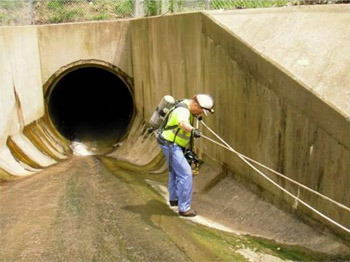
Showing Buried Streams the Daylight
Researchers compare the effectiveness of buried streams versus open-air streams for removing harmful nitrogen from water systems
Dark, wet and ever-flowing, but rarely seen. If you live in a city, they are all around you, but you would never even know it. They are buried streams—waterways that once flowed over land but were routed into underground pipes to make way for urban development.
New EPA research suggests that these buried streams may contribute to the degradation of water quality in this country. Consequently, scientists offer a simple solution: un-bury the streams.

"It's pretty creepy," says ecologist Dr. Paul Mayer about visiting buried streams. "There's actually a high danger factor just in moving around. Nobody has ever looked at buried streams and it's partly because it's really hard to do the research." EPA Health and Safety personnel inspected the air quality in buried stream pipes before researchers ventured down to collect data.
Researchers hypothesized that buried streams are less effective at removing nitrogen than streams above ground that are open to daylight and air. Excess nitrogen is a major contributor to nutrient pollution, which can spark algae blooms and other problems for streams and other waterways and can be unhealthy to people if it taints drinking water sources.
To test their theory that buried streams may be contributing to the overabundance of nitrogen in U.S. waters, EPA researchers selected three streams in Baltimore and three in Cincinnati that had both above and underground stream sections. By monitoring segments of each over the course of a year, researchers will be able to compare nitrogen concentrations in daylighted streams to those in buried streams.
“So far what we found is that the daylighted streams are far more effective than buried streams at processing nitrogen, up to 23 times more effective,” says ecologist Dr. Paul Mayer explaining the preliminary results.
Reducing Nitrogen and Other Benefits
The results of the research may reveal a likely solution for urban city managers looking for a way to improve their water quality. Buried streams under vacant lots or city parks could be dug up and restored to their natural above-ground state—a process called daylighting—as a method for removing nitrogen from the water system. Successful daylighting projects have already been completed in cities around the world including Seoul, London, and Philadelphia.
Excess nitrogen is a major impairment to the nation’s waters. Nitrogen from agricultural, industrial, and urban sources enters inland waterways in abundance. Since streams and rivers carry their nutrient load downstream, coastal environments like the Gulf of Mexico suffer the consequences. The Gulf’s “Dead Zone” has been so affected by nitrogen overload that aquatic life cannot survive.
“Basically, if you care about the health of our coastal waters, if you care about the robustness of the fisheries and the economic activities associated with coastal waters, then nitrogen is an issue you should be concerned about,” remarks Dr. Jake Beaulieu, the EPA scientist leading the research effort. “We believe that stream daylighting should be viewed as one of the tools we have to try to address this issue.”
Why does daylighting help nitrogen removal? Bacteria living in the sediments of above ground streams and rivers convert nitrogen in the water (in the form of nitrate) into nitrogen gas, a benign form of nitrogen that leaves the water and enters the atmosphere. However, buried stream environments do not support many of these bacteria so less nitrogen is removed from buried waters. The natural process of nitrogen removal—called denitrification—inspired scientists to search for ways to harness it to improve water quality.
Mayer explains, “If we find that daylighting a stream and exposing it to the world can be very effective at removing nitrogen, then this could be a best management practice for cities to pursue in lieu of trying to redesign their sewer infrastructure or trying to implement something that is far more expensive.”
Daylighting streams may also provide cities with a novel approach for dealing with sewer overflows. By uncovering buried streams, water would flow along the surface instead of being routed through city pipes. For cities facing challenges to both improve water quality and decrease sewer overflows, a daylighting stream approach may offer a dual solution.
Another potential advantage of stream daylighting is neighborhood revitalization, particularly in run-down and currently vacant areas.
“It may be a case where that simple act of creating this daylighted stream can create a center for commercial or residential development,” says Mayer. “Neighborhoods may be rejuvenated in a way that brings people back to those neighborhoods and kind of supercharges that part of the city.”
Study results are expected by the end of 2012. The outcomes of this project and further research will be used to inform a new modeling tool for urban managers. This tool will help identify places within a city where daylighting streams would be most effective.
